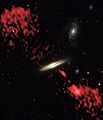| ESO 0313-192 | |
|---|---|
 ESO 0313-192 (left), as taken from Hubble Space Telescope (HST), next to LOY2001 (right) | |
| Observation data (J2000 epoch) | |
| Constellation | Eridanus |
| Right ascension | 03h 15m 51.80s [1] |
| Declination | −19° 06′ 45.0″ [1] |
| Redshift | 0.067±0.0002 [2] [ failed verification ] |
| Distance | 1 Bly (225.9 Mpc) [3] |
| Group or cluster | Abell 428 [1] |
| Apparent magnitude (V) | 17.48 [1] |
| Characteristics | |
| Type | SA(s)ca (spiral radio galaxy) |
| Size | 1.5 million ly (radio lobe(s)) |
| Apparent size (V) | 0.69 x 0.14 [1] |
| Notable features | active galactic nuclei |
| Other designations | |
| LEDA 97372, [2] 2MASX J03155208-1906442, [2] NVSS J031552-190638, [2] [LO95] 0313-192 [4] | |
ESO 0313-192 (also known as PGC 97372 and LO95 0313-192) is an edge-on spiral galaxy, or a double-lobed radio galaxy located around 1 billion light-years away in the constellation Eridanus. [2] Its radio jets were discovered in 2003 by NASA, and its radio lobes are an estimated 1.5 million light years in diameter. [1] It is part of the cluster Abell 428, and it has an active galactic nuclei. [3]

